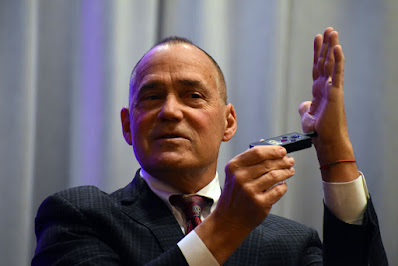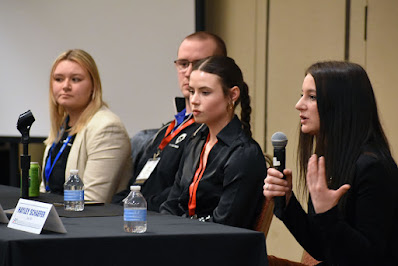 |
| From Reuters, Time magazine released image of it's Taylor Swift covers. |
As a choice for 2023, I don’t think Time Magazine missed by naming Taylor Swift as its person of the year.
In some ways, it’s her second time, since she was part of the group of women on the cover when “The Silence Breakers” appeared in 2017.
But there’s no doubt that Taylor Swift is huge this year, and it’s a testament to her enduring power as a performer. She’s lasted 16 years as a star in the fickle world of popular music, and she has used some savvy moves to make herself the center of an entertainment empire. Which culminated this year with the ongoing Eras tour/movie and the cover of Time.
When Swift first started to make it as a singer, I wasn’t much of a fan. Her early songs were country pop, and that’s not my jam. “Tim McGraw,” her 2006 first hit, isn’t something I’ve listened to very often.
With Swift, her songs are often promoted by and appear as popular videos, and the one for “Love Story,” 2008, is slickly produced, but the arc of the song is irritating to me. The country music feel here didn’t help, but the real “Romeo and Juliet” wasn’t a love story, it was a tragedy about manic infatuation that left a trail of bodies in its wake. If he was Romeo and you were Juliet, you two would be dead now.
Then again, I didn’t hate early Taylor. “You Belong with Me,” 2009, shows that her voice has matured a bit. Her lyrics were getting better, and her sound is transitioning.
It’s still country, but definitely more at the pop end. And, true, the video is ridiculous, with evil (dark) Taylor contrasted with nice (blonde) Taylor—and Swift’s female pop-singer supermodel level good looks make her ineffective playing the wallflower.
Since those early years, Swift’s songs have grown more sophisticated and relatable. She began to get sassier and edgier after her teen moon-eyed faze.
Think of “Mean,” released in 2011. Still country, but the lyrics are getting more fun. “Someday, I’ll be living in a big old city and all you’re ever going to be is mean.” Maybe it’s a little thin skinned, but given where she is now, I guess I’d have to say it’s accurate foreshadowing—someday she did indeed become big. And big is an understatement, although she wasn't all that small in 2011, either.
I was getting a bit more into Taylor Swift. 2013 was the year of “22,” and “Red.” “Red” seems so raw and sincere—a song I can listen to.
And “22”? Even in my 60s, I can recall being that young, and Swift captures the feeling of young adulthood very well.
Plus: “happy, free, confused, and lonely at the same time” is a way many of feel at any stage of life.
More mainstream pop and more adult Taylor Swift produced one of the most watchable music videos ever in 2014: “Blank Space.” And that year, she also advised us that she was going to “Shake it Off” about media critiques of her life.
The "Shake it Off" video shows a woman at the top of her video-making and song-making game.
Thus, by about 10 years ago, Taylor Swift was creating songs that an old man still finds interesting, relatable and listenable—and she’s only grown from there. In 2019, there was “You Need to Calm Down.”
A rumination on both anti-homosexual culture and the nature of celebrity, "Calm Down" is a relevant, interesting song. Totally on my playlist today.
Then came 2020, and “The Man,” one of my favorite Taylor Swift songs and music videos. Yeah, the nature of media attention to you would be very different, Taylor, if you were a guy Taylor rather than a girl Taylor, and way to point that out.
I tend to be a little behind in listening to Taylor Swift’s music, so I don’t have as much to state on her more recent songs, except that perhaps my favorite Swift song of all time, so far, is 2022’s “Anti-Hero.”
“I have this thing where I get older but just never wiser, midnights become my afternoons.” In my speech classes, I try to teach students to begin any public discourse with an attention-grabber—and has anybody ever heard those opening lines and not wondered what’s coming next? And what comes next is, to me, interesting and compelling poetry.
“I’ll stare directly at the sun but never in the mirror.” It’s always easier to look out at the world, even to burn our eyes with a dangerous look (don’t stare directly at the sun) than it is to understand the self, to stare directly in the mirror.
“Did you hear my covert narcissism I disguise as altruism, Like some kind of congressman? (Tale as old as time).” Give Swift credit, she seems to be doing a bit of mirror looking here.
I have mixed feelings about the official music video for Anti-Hero—the little sit-com funeral scene is OK, but interrupts the song. Since she wrote and directed it, I blame Taylor Swift for that. It’s her, she, she’s the problem.
But I love the song. It touches on one of the great human problems—in all of our lives, isn’t it often true that we feel like monsters on the hill rather than sexy babies? And don't all of us sometimes recognize "I'm the problem?" So here is the lyric version of the song video; it's not as much fun as the official song video, but uninterrupted:
A few weeks ago, I was at an event put on by Guardian Institute of Martial Arts, a school in Marion that is run by my daughter and her husband. Some of the black belt Taekwondo instructors there are teen girls. I think it could have been my daughter, but someone mentioned to them at that event that I’m a Swift fan.
Three of them came over to ask. Yes, I said, I am a bit of a Swiftie. No, I know, I’m not as obsessed with Taylor Swift as a true Swiftie is, nor do I have a friendship bracelet. I meant that I am aware of her music and that I’ve grown to enjoy it. I am a fan.
The girls were pretty excited about that. They love TS, too. And that’s nice. Often, popular music and musical choices shift with time. For most of us, our most enduring favorite songs were ones that we encountered as teens or young adults—there’s something about the soundtrack of key transitions in our lives that sticks with us, like the smell of fresh bread baking that can draw you back into your mom’s kitchen. When I hear an early Heart song, I’m taken back to my youth.
But I don’t mind listening to newer music. And I don't know what is says about me, but I do have a thing about female performers. While I can think of many men whose music I enjoy, I am drawn to female singers.
And enjoying new creations, I think, is important as I age. I still live in the world of today. True, these days, music is over-produced, and there was some raw energy and honesty in the pre-disco music of the 1970s that I really like. Yet here I am. Taylor Swift is person of the year. It’s a meaningless media accolade, but I don’t mind this weird annual ritual created by Time magazine.
And I don’t argue with the choice this year.
















.jpg)





























